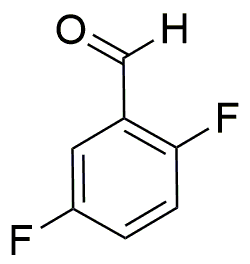2,5-Difluorobenzaldehyde is widely utilized in research focused on:
- Synthesis of Pharmaceuticals: This compound serves as a key intermediate in the synthesis of various pharmaceutical agents, particularly in the development of anti-cancer and anti-inflammatory drugs.
- Fluorescent Probes: It is employed in creating fluorescent probes for biological imaging, enhancing the visualization of cellular processes in research and diagnostics.
- Organic Synthesis: Used in the preparation of complex organic molecules, it allows chemists to explore new chemical reactions and develop innovative materials.
- Material Science: The compound is incorporated into polymers and resins, improving their thermal stability and mechanical properties, which is beneficial in manufacturing durable materials.
- Environmental Applications: It plays a role in the development of sensors for detecting environmental pollutants, contributing to efforts in monitoring and improving air and water quality.
General Information
Properties
Safety and Regulations
Applications
2,5-Difluorobenzaldehyde is widely utilized in research focused on:
- Synthesis of Pharmaceuticals: This compound serves as a key intermediate in the synthesis of various pharmaceutical agents, particularly in the development of anti-cancer and anti-inflammatory drugs.
- Fluorescent Probes: It is employed in creating fluorescent probes for biological imaging, enhancing the visualization of cellular processes in research and diagnostics.
- Organic Synthesis: Used in the preparation of complex organic molecules, it allows chemists to explore new chemical reactions and develop innovative materials.
- Material Science: The compound is incorporated into polymers and resins, improving their thermal stability and mechanical properties, which is beneficial in manufacturing durable materials.
- Environmental Applications: It plays a role in the development of sensors for detecting environmental pollutants, contributing to efforts in monitoring and improving air and water quality.
Documents
Safety Data Sheets (SDS)
The SDS provides comprehensive safety information on handling, storage, and disposal of the product.
Product Specification (PS)
The PS provides a comprehensive breakdown of the product’s properties, including chemical composition, physical state, purity, and storage requirements. It also details acceptable quality ranges and the product's intended applications.
Certificates of Analysis (COA)
Search for Certificates of Analysis (COA) by entering the products Lot Number. Lot and Batch Numbers can be found on a product’s label following the words ‘Lot’ or ‘Batch’.
*Catalog Number
*Lot Number
Certificates Of Origin (COO)
This COO confirms the country where the product was manufactured, and also details the materials and components used in it and whether it is derived from natural, synthetic, or other specific sources. This certificate may be required for customs, trade, and regulatory compliance.
*Catalog Number
*Lot Number
Safety Data Sheets (SDS)
The SDS provides comprehensive safety information on handling, storage, and disposal of the product.
DownloadProduct Specification (PS)
The PS provides a comprehensive breakdown of the product’s properties, including chemical composition, physical state, purity, and storage requirements. It also details acceptable quality ranges and the product's intended applications.
DownloadCertificates of Analysis (COA)
Search for Certificates of Analysis (COA) by entering the products Lot Number. Lot and Batch Numbers can be found on a product’s label following the words ‘Lot’ or ‘Batch’.
*Catalog Number
*Lot Number
Certificates Of Origin (COO)
This COO confirms the country where the product was manufactured, and also details the materials and components used in it and whether it is derived from natural, synthetic, or other specific sources. This certificate may be required for customs, trade, and regulatory compliance.


